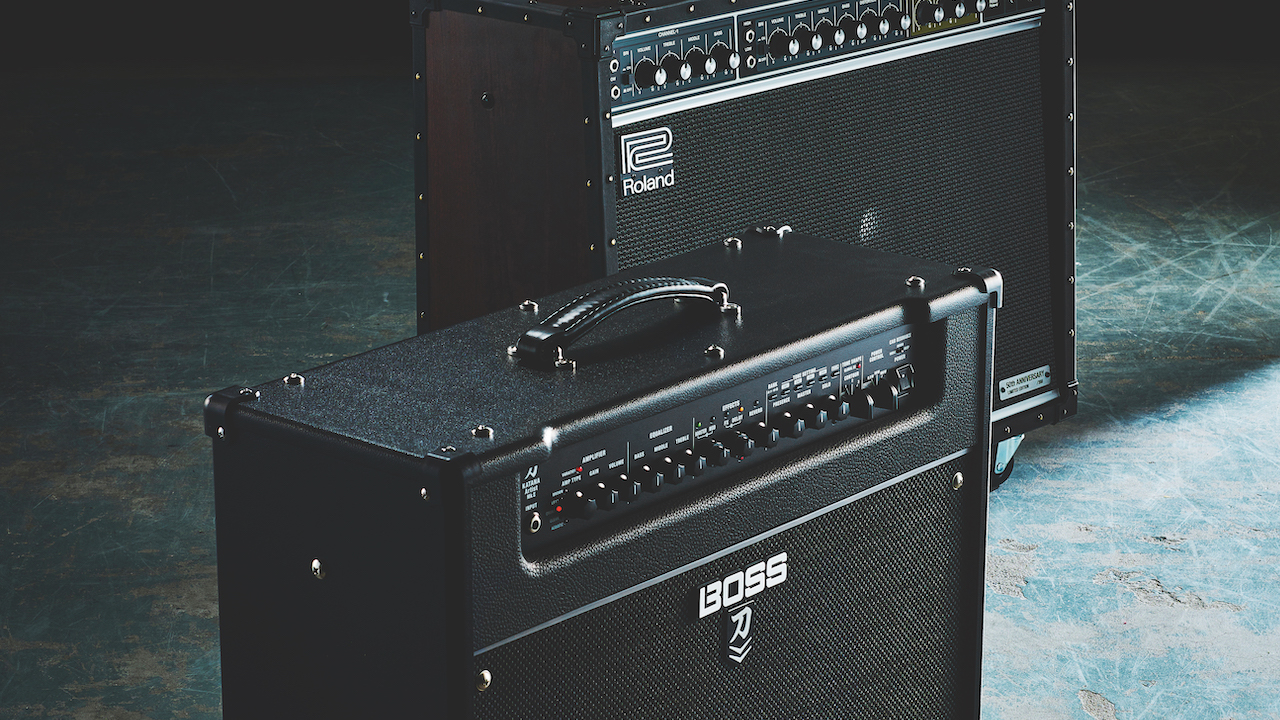How BOSS became one of the world's biggest guitar amp companies in under a decade
BOSS’s status as an effects heavyweight is set in stone – but lesser-known is how the visionary company reached the summit of the amp sector in under a decade

Breaking into the modern amp market is not a mission for the faint-hearted. On one side, you’ll find the old guard, eternally sworn to the valve technology they created back in the 50s and 60s, still dining out on war-stories of Hendrix, Woodstock and 4x12 backlines looming like monoliths. On the other, the high-tech disruptors, shredding conventional wisdom, casting aside manufacturing tradition, and dragging the sector ever-further from physical hardware towards apps and plug-ins.
Both philosophies are valid, and each has its advocates. But if BOSS’s status as the second-biggest amp builder in the world proves anything, it’s the appetite for products that walk a perfect middle path between tradition and revolution. Inspect the modern BOSS amp range – comprising the Katana, Nextone, Waza, CUBE and Acoustic series – and you’ll find hardware that feels reassuringly human, offering the hands-on tangibility that makes plugging into a great amp so satisfying.
Look a little closer, though, and you’ll detect the innovation that underpins BOSS’s design philosophy, with lively and responsive amp sounds called up at the twist of a dial, signature tones crafted using editing software, and a thousand other paradigm-shifting leaps.
To some, BOSS’s rise as an amp builder might seem like an overnight success, sparked by the runaway sales of the Katana series from 2016. In fact, there’s a precedent and considerable pedigree underpinning the boom.
Anyone with even a passing knowledge of the amp scene will recall that sister company Roland had already planted its flag in 1975 with the legendary JC-120, a 2x12 combo dubbed the ‘king of clean’ for its glassy, stereo chorus-sweetened shimmer, seen in the rigs of everyone from Metallica’s James Hetfield to The 1975.
Likewise, by 1978, the ultra-portable CUBE series – then a Roland range, rebranded as BOSS in 2021 – gave musicians on the move a professional level of performance for the first time.
At the top end, from 2014, the Blues Cube was attracting some of the scene’s most discerning names, from Eric Johnson to Robben Ford. As for BOSS, scan the history books and you’ll find the brand dipped a toe into the market with tidy practice combos like the MG-10 (released in the mid-80s and long-discontinued).
Get The Pick Newsletter
All the latest guitar news, interviews, lessons, reviews, deals and more, direct to your inbox!
But it wasn’t until the post-millennium era that the Japanese firm truly forged into the amp sector with full intent, capturing the public imagination for something other than its rainbow of globally acclaimed effects pedals.

Everything changed in 2016. That January, BOSS announced its ambitions and reset the norm with the launch of the 150-watt Waza Amp Head: a four-channel tone machine that earned admiring reviews for the organic, frayed-edge response of its Tube Logic circuitry, delivered through a stylish 2x12 or 4x12 cab. “It’s an attractive alternative to a tube head,” wrote Guitar World, “ready for the biggest stages.”
But BOSS had another ace to play, and later that year came the big reveal that sent ripples through the amp scene. Even before you saw the hardware in the flesh, the Katana sounded evocative, aptly named after the traditional curved sword carried by Japan’s ancient samurai warriors, in a nod to the new amp’s precision and artistry. Just as compelling was the pitch, with a press release welcoming a new amp series that “embodies BOSS’s determined pursuit of the ultimate rock sound”.
But that first wave of Katana amps – a line-up comprising the Katana-100, Katana-100/212, Katana-50 and Katana-Head – only revealed the true extent of their powers when a player pushed a guitar lead into the input jack. It only took a few riffs to realize that, for the first time, authentic valve-worthy tones and forward-thinking modern features could co-exist in harmony. Uniquely, the Katana hit the neglected sweet spot between time-honored and template-breaking philosophies – and sat within reach of budget-conscious working musicians, to boot.

Today, firing up a Katana amp for the first time is still a revelation, the range’s garage-band pricing at odds with a professional spec that suggests a boutique recording amp.
Since the range was introduced in 2016 it has steadily grown to include: premium Katana-Artist models; the desktop Katana-Air; the newly released Katana-Air EX; and the ultra-compact Katana-Mini. Regardless of the specific model there are features in common.
Most players start with the Amp Type dial, cycling their sound between Clean, Crunch, Lead, Brown and Acoustic (Brown offering BOSS’s sonic salute to Eddie Van Halen’s famously warm and characterful ‘brown’ sound).
Nominally, then, the Katana could be classed as a ‘modelling amp’. But that term doesn’t do justice to the gulf between less refined products claiming to recreate famous valve amp tones and the Tube Logic circuitry at the heart of these Japanese-built amplifiers, which genuinely brings the alive-in-your-hands response of a valve glowing red-hot.
It’s complemented by the Class A/B analogue power amp section, which underlines that organic, character-soaked response, and delivers it through custom-designed speakers that make the air move. Meanwhile, the Variable Power Control lets players dig out those same fit-to-burst tones at feasible home volumes.
But perhaps the masterstroke of the Katana range is that it stands on the shoulders of a half-century of guitar-effects innovation. Boasting 60-plus effects, taken direct from BOSS’s key stompboxes since the 70s – not to mention the ability to edit, store or deep-dive with the almost-infinite voicings of BOSS Tone Studio software – the Katana feels like a blank canvas, making each guitarist feel like they own a custom-tuned signature amp, no matter how many millions of players start from the same factory-spec foundation. As MusicRadar’s Daryl Robertson wrote earlier this year of the Katana-50 MkII EX: “There is no genre this amp cannot do.”
It was true, and from its launch in 2016, the Katana swiftly cut a swathe across stages worldwide, appearing everywhere from the backlines of school bands to the rigs of pro players like Andy James, Ola Englund and Rabea Massaad.
“The Katana-Artist is a really impressive addition to the range,” said the YouTuber of the premium model released in 2018. “For all those guys wanting to gig and keep everything in one box – whether it be all your effects, the functionality, the different tones – this is a great option. I can’t fault it. But then, I couldn’t fault the other Katana amps…”

With over one million Katana amps sold, a less adventurous firm might have marked time. But BOSS’s next move underlined its refusal to rest on past glories. By 2018, the whispers in gear circles told of a brand-new BOSS amplifier range, pushing the concept of valve-less guitar amps to unprecedented levels. Enter the Nextone.
At first glance, these latest combos (originally released in 80-watt Artist 1x12 and compact 40-watt Stage variants) offered a more traditional amp experience, finished with silver-trim grille cloth, featuring familiar Clean and Lead channels and a streamlined selection of core effects (reverb, delay, tremolo and boost).
But the giant leap came in the choice of four Class A/B analogue power amp circuits, with a twist of the rotary knob letting players travel through time and cross the Atlantic, choosing between the proud bark of US-style 6L6/6V6 voicings and the creamy roar of the EL34/EL84 valves associated with the golden age of British rock.
Remarkably, the Nextone didn’t just sound like a line-up of classic valve amps: it truly felt and reacted like each one of them, with the series’ Tube Logic foundation meaning each power amp mode revoiced the entire circuit from input to output. “In use, the Nextone sounds scarily realistic,” wrote Nick Guppy in Total Guitar. “It’s one of the best-sounding solid-state amps on the market.”
To excel at one design discipline is hard enough. To excel at two is a rare feat indeed. But in the post-millennium, BOSS is acknowledged as a specialist across both pedalboard and backline, its effects and amplifiers offering a one-stop solution for tone that turns heads. The future of amplification has truly arrived.
This month, Guitarist magazine includes a free supplement dedicated to 50 Years of BOSS. Click here to download it as a digital version or here for a 'digital page-turner' on Issu.
Henry Yates is a freelance journalist who has written about music for titles including The Guardian, Telegraph, NME, Classic Rock, Guitarist, Total Guitar and Metal Hammer. He is the author of Walter Trout's official biography, Rescued From Reality, a talking head on Times Radio and an interviewer who has spoken to Brian May, Jimmy Page, Ozzy Osbourne, Ronnie Wood, Dave Grohl and many more. As a guitarist with three decades' experience, he mostly plays a Fender Telecaster and Gibson Les Paul.
“If you’ve ever wondered what unobtanium looks like in amp form, this is it”: Played and revered by Stevie Ray Vaughan, Carlos Santana, and John Mayer, Dumble amps have an almost mythical reputation. But what's all the fuss really about?
“For the price, it’s pretty much unbeatable”: Harley Benton JAMster Guitar review



![[from left] George Harrison with his Gretsch Country Gentleman, Norman Harris of Norman's Rare Guitars holds a gold-top Les Paul, John Fogerty with his legendary 1969 Rickenbacker](https://cdn.mos.cms.futurecdn.net/TuH3nuhn9etqjdn5sy4ntW.jpg)







